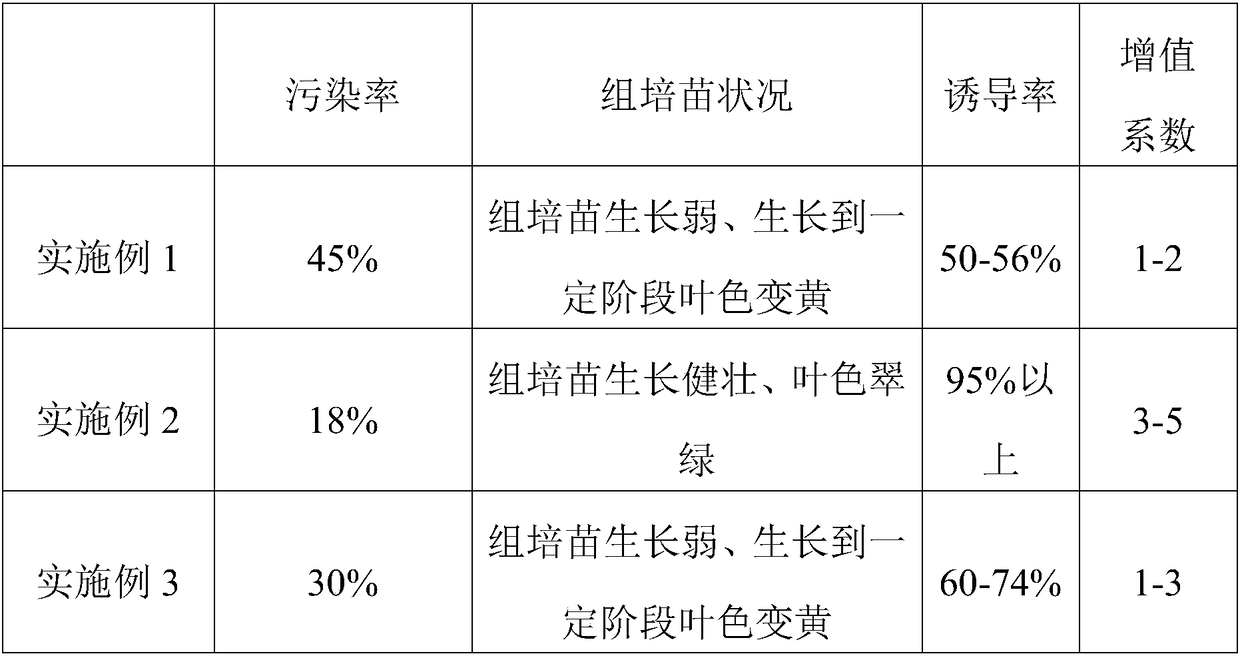Method for preventing lesser bougainvillea flower tissue culture seedlings from yellowing
A technology of flower groups and leaves, applied in the field of preventing yellowing of bougainvillea tissue cultured seedlings, can solve problems such as yellowing of bougainvillea tissue cultured seedlings, achieve good sterilization effect, prevent yellowing, and prevent yellowing
- Summary
- Abstract
- Description
- Claims
- Application Information
AI Technical Summary
Problems solved by technology
Method used
Image
Examples
Embodiment 1
[0021] Method for assaying bougainvillea pollen vigor of the present invention, comprises the steps:
[0022] 1. Selection of explants: At 10 a.m. in the morning on a sunny day, collect the young shoots of the current year on a strong, disease-free mother plant.
[0023] 2. Disinfection treatment: ①Take the collected young shoots back to the laboratory, gently wipe off the epidermal hairs with a rag, and rinse them with tap water; ②Cut them into 6-7cm long sections, put them in a beaker, and cover the beaker with clean gauze ③ Put the soaked and rinsed young shoots into the ultra-clean workbench, first sterilize with 75% alcohol for 30 seconds, and keep shaking the bottle to make the explants fully contact with the alcohol and aseptic Rinse with water 4-5 times; ④ Then sterilize with 0.1% mercuric chloride for 8 minutes, shake the bottle constantly during this period to ensure that each explant can be fully sterilized, and rinse with sterile water 5-6 times.
[0024] 3. Inocu...
Embodiment 2
[0028] 1. Selection of explants: At 10 a.m. in the morning on a sunny day, collect the young shoots of the current year on a strong, disease-free mother plant.
[0029] 2. Disinfection treatment: ①Take the collected young shoots back to the laboratory, gently wipe off the epidermal hairs with a rag, and rinse them with tap water; ②Cut them into 6-7cm long sections, soak them in potassium permanganate for 5 minutes, and soak them in carbendazim 8 minutes, then put it in a beaker, cover the mouth of the beaker with clean gauze, and rinse it under tap water for 2-3 hours; ③ Bring the soaked and rinsed young shoots into the ultra-clean workbench, first disinfect with 75% alcohol for 30 seconds, and keep Shake the bottle to fully contact the explants with alcohol, rinse them with sterile water 4-5 times; ④ then sterilize with 0.1% mercuric chloride + 0.05% Tween 80 for 8 minutes, and keep shaking the bottle during this period to ensure that each explant can be Fully disinfect and r...
Embodiment 3
[0034] 1. Selection of explants: In rainy weather, collect the young shoots of the year on the mother plant that is strong and free of diseases and insect pests.
[0035]2. Disinfection treatment: ①Take the collected young shoots back to the laboratory, gently wipe off the epidermal hairs with a rag, and rinse them with tap water; ②Cut them into 6-7cm long sections, put them in a beaker, and cover them with clean gauze Rinse the mouth of the beaker under tap water for 2-3 hours; ③ Bring the soaked and rinsed young shoots into the ultra-clean workbench, first disinfect with 75% alcohol for 30 seconds, and keep shaking the bottle to make the explants fully contact with the alcohol, without Rinse with bacterial water 4-5 times; ④ Then sterilize with 0.1% mercuric chloride + Tween for 8 minutes, shake the bottle constantly during this period to ensure that each section of explant can be fully sterilized, and rinse with sterile water 5-6 times.
[0036] 3. Inoculation: ① Place the ...
PUM
 Login to View More
Login to View More Abstract
Description
Claims
Application Information
 Login to View More
Login to View More - R&D
- Intellectual Property
- Life Sciences
- Materials
- Tech Scout
- Unparalleled Data Quality
- Higher Quality Content
- 60% Fewer Hallucinations
Browse by: Latest US Patents, China's latest patents, Technical Efficacy Thesaurus, Application Domain, Technology Topic, Popular Technical Reports.
© 2025 PatSnap. All rights reserved.Legal|Privacy policy|Modern Slavery Act Transparency Statement|Sitemap|About US| Contact US: help@patsnap.com

